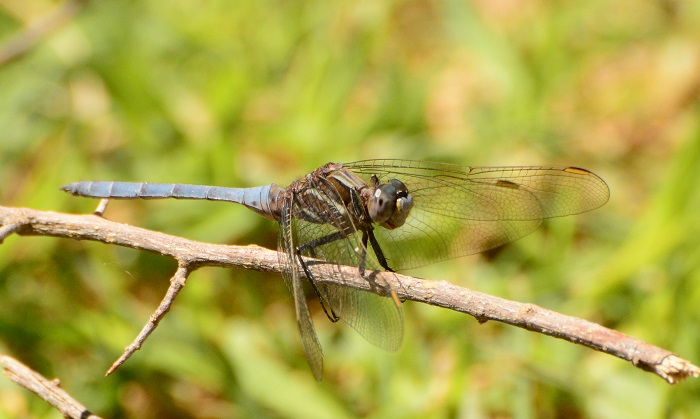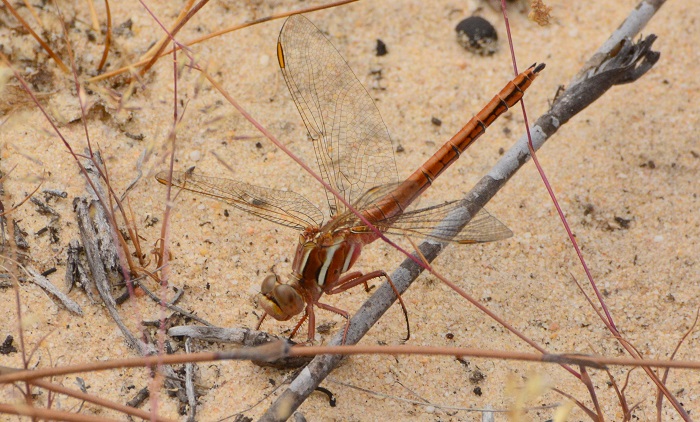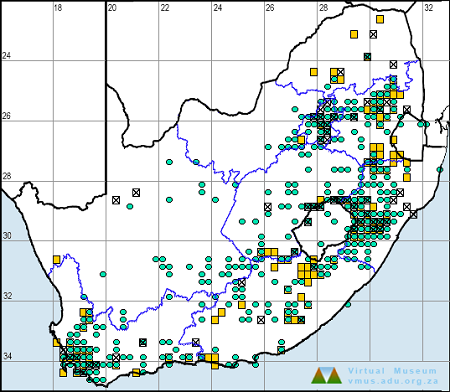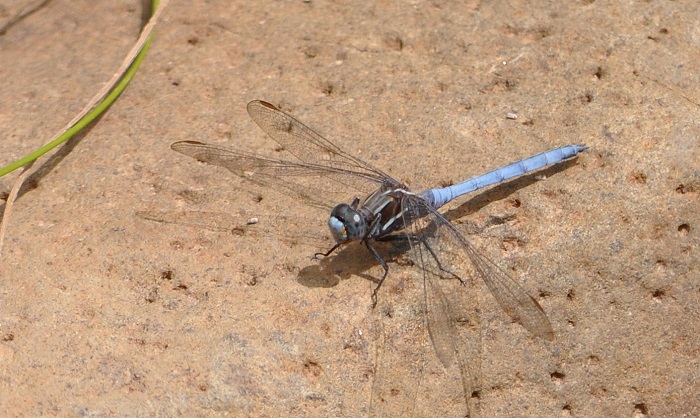Cover photo by Katharina Reddig.
Find this species in the FBIS database (Freshwater Biodiversity Information System) here.
Family Libellulidae
Identification

Near Ixopo, KwaZulu-Natal
Photo by Ryan Tippett
Medium sized
Length up to 45mm; Wingspan attains 68mm.
Both sexes of the Two-striped Skimmer are among the more readily identified Orthetrum species, due to the two diagonal stripes on the sides of the thorax.
In fully pruinose males the diagnostic white stripes may become partially or completely obscured. These males are best identified by the shape of the secondary genitalia.
The Two-striped Skimmer is most likely to be confused with the Epaulet Skimmer (Orthetrum chrysostigma), but that species has only one pale, diagonal stripe on the thorax sides.
Click here for more details on identification.

Near Ixopo, KwaZulu-Natal
Photo by Ryan Tippett
Habitat
The Two-striped Skimmer is most common in higher-altitude or mountainous areas, including the arid Karoo. The preferred habitats are open margins of rivers, pans, water-holes, and dams. The Two-striped Skimmer frequents areas with low grassy or bushy growth, and also bare exposed areas and rocks near the water.

Photo by Ryan Tippett
Behaviour
The Two-striped Skimmer often perches on the ground or rocks, but also sits on twigs and other similar perches in or near the water. It hunts from a perch and quickly resettles again. The Two-striped Skimmer can often be found away from water along pathways, on lawns, and at other suitable sites. Both sexes are found in the same vicinity.

Carnarvon district, Northern Cape
Photo by Ryan Tippett
Status and Conservation
The Two-striped Skimmer is common and widespread in South Africa. It is listed as of Least Concern in the IUCN Red List of Threatened Species. The Two-striped Skimmer is an adaptable species that readily frequents degraded and man-made habitats.

Swartberg Pass, Western Cape
Photo by Ryan Tippett
Distribution
Orthetrum caffrum is widespread throughout most of southern, central, and eastern Africa. In South Africa, it is only absent from the hot, humid areas of the lowveld and north-eastern KwaZulu-Natal.

Cedarberg, Western Cape
Photo by Ryan Tippett
Below is a map showing the distribution of records for Two-striped Skimmer in the OdonataMAP database as at February 2020.

Below is a map showing the distribution of records for Two-striped Skimmer in the OdonataMAP database as of December 2024.

The next map below is an imputed map, produced by an interpolation algorithm, which attempts to generate a full distribution map from the partial information in the map above. This map will be improved by the submission of records to the OdonataMAP section of the Virtual Museum.


Ultimately, we will produce a series of maps for all the odonata species in the region. The current algorithm is a new algorithm. The objective is mainly to produce “smoothed” maps that could go into a field guide for odonata. This basic version of the algorithm (as mapped above) does not make use of “explanatory variables” (e.g. altitude, terrain roughness, presence of freshwater — we will be producing maps that take these variables into account soon). Currently, it only makes use of the OdonataMAP records for the species being mapped, as well as all the other records of all other species. The basic maps are “optimistic” and will generally show ranges to be larger than what they probably are.
These maps use the data in the OdonataMAP section of the Virtual Museum, and also the database assembled by the previous JRS funded project, which was led by Professor Michael Samways and Dr KD Dijkstra.

Sani Pass, KwaZulu-Natal
Photo by Ryan Tippett
Further Resources
The use of photographs by Katharina Reddig is acknowledged. All other photographs by Ryan Tippett.
Two-striped Skimmer Orthetrum caffrum (Burmeister, 1839)
Other common names: Strepieskepper (Afrikaans)
Recommended citation format: Loftie-Eaton M; Navarro R; Tippett RM; Underhill L. 2025. Two-striped Skimmer Orthetrum caffrum. Biodiversity and Development Institute. Available online at https://thebdi.org/2020/06/19/two-striped-skimmer-orthetrum-caffrum/
References: Tarboton, M; Tarboton, W. (2019). A Guide to the Dragonflies & Damselflies of South Africa. Struik Nature.
Samways, MJ. (2008). Dragonflies and Damselflies of South Africa. Pensoft
Samways, MJ. (2016). Manual of Freshwater Assessment for South Africa: Dragonfly Biotic Index. Suricata 2. South African National Biodiversity Institute, Pretoria
Martens, A; Suhling, F. (2007). Dragonflies and Damselflies of Namibia. Gamsberg Macmillan.

Carnarvon district, Northern Cape
Photo by Ryan Tippett

